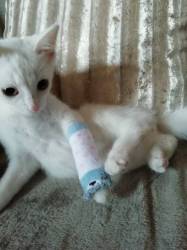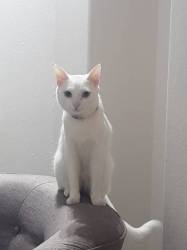Written by Lynette Nicholson, Founder of Nicholson Rescue
DISCLAIMER: I’m not a veterinarian and can’t comment from a professional medical perspective, and what I’ve written reflects only my experience.
Photography courtesy of Eben Roets
A handful of kittens dying of a mysterious illness was the red flag that alerted us to the return of a disease feared by kitten rescuers everywhere…
A devastating disease rears its ugly head
Nicholson Rescue has been operating a private kitty rescue organisation since 2013, during which time we’ve successfully rehomed about 3,000 cats and kittens. About two years ago, a few of our kittens died with no obvious cause of death.
Feline Infectious Peritonitis (FIP) and Fading Kitten Syndrome were suggested as possible causes, but neither sat right with us; the symptoms didn’t fit FIP and Fading Kitten Syndrome is just a name given to something scientists don’t yet understand.
In desperation, I contacted a well-known and respected rescuer in Johannesburg. She listened to my story and mentioned a word that will forever haunt me: panleukopenia.
We approached our vets and told them about our suspicions. They hadn’t been presented with a case of feline panleukopenia (FP) for decades and so, unsurprisingly, were somewhat sceptical. Nonetheless, they ran the necessary tests and confirmed that this devastating disease had reared its ugly head.
Horrific days ahead
While we were satisfied that we at least knew what we were dealing with, nothing could prepare us for the horrific days ahead.
Once you’ve had a case of FP – also called Feline Infectious Enteritis or Feline Parvoviral Enteritis – in your rescue organisation, all your cats and kittens have been exposed to it. It becomes a terrible waiting game to see which ones become ill. The virus is so contagious that every effort to clean and sanitise may not be enough. Our older cats and kittens who’d had their vaccinations (at least two vaccinations) were fine, and we never lost any of them. But some of the kittens which had had only one vaccination were infected; sadly, some didn’t make it.
The path of this horrible disease is very varied. Sometimes a kitty will go from seeming to be 100% healthy to dead within 24 – 48 hours; other times they’ll be sick for a week or more before either recovering or succumbing. What’s absolutely critical if the kitty is to have any chance of surviving is early diagnosis and treatment.
Signs and treatment
In our experience, the first sign of panleukopenia is frothy yellow vomit. Still today, my stomach goes into a knot if I see or hear of kittens vomiting yellow froth. Lethargy and lack of appetite are also signs, as well as diarrhoea. Those infected feel extremely nauseous and therefore cannot eat. Even trying to syringe feed doesn’t work because they vomit up their food. Keeping them warm is, of course, essential, but it’s the administration of subcutaneous fluids that’s vital if the kitten/cat is to stand any chance. Dehydration kills. Fortunately, our vet taught us how to do this, and we’re able to provide the treatment at home, through the night when necessary.
The survival rate of panleukopenia is low, and while we’ve brought a fair number of kittens through the virus who recovered fully, I’d say that our rate of survival, even with “round-the-clock” nursing, has been about 40 – 50%.
While I’m not a vet and can’t talk from a veterinary professional viewpoint, following veterinary advice, we’ve treated with a general antibiotic, Metronidazole and Oseltamivir, with regular doses of subcutaneous fluid and dextrose. However, I can’t say with any certainty that any of these protocols are a cure for FP, as I’ve had some kittens survive and some die while on these meds, but at least it’s something.
The importance of vigilance and vaccination
We recently took in three kittens who were confined in my home for two hours while we waited for a foster mom to fetch them. Unbeknown to us, they had FP, although they weren’t symptomatic at that stage. They went to a foster mom and got sick two days later – FP was diagnosed. Due to them being in my home for that very short time, the virus was in my home, and we lost three more kittens (who didn’t even come into contact with the original three) over the next week.
It seems that this horrendous virus is showing up more and more recently. All of us in rescue, and even those households with domestic cats, need to be very vigilant. We need to ask our vets to test for the virus if there’s any concern or if kittens/cats are presenting with any of the signs.
The good news is that FP can be prevented. Keeping up to date with vaccinations is vital. The panleukopenia vaccination is part of the standard vaccine which all kittens and cats must get. It’s also essential that cats and kittens get their booster shots, which will be a defence against this virus.
Work together to beat Feline Panleukopenia
Unfortunately, not all rescue organisations and shelters are aware that they have or have had an FP outbreak, and if they are aware, some are reluctant to admit it. This is certainly not something to be ashamed of or to hide. If you’re in rescue, you’re bound to come across this virus at some point – it’s part of what we do.
We need to be working together to fight this virus and get it under control – and the only way we can do this is by being open and alerting others to outbreaks. The more information we have, the more prepared we can be.
To this end, Nicholson Rescue has been working with developers to implement an online reporting app that will be available to all vets, shelters, and rescue organisations whereby the logging of panleukopenia cases can be easily done and tracked. This will enable all of us to better understand the spread of the virus, identify potential hotspots, and potentially understand treatment protocols.
From this platform we’ll also be able to share panleukopenia insights with vets and rescues through blogs and updates, and sharing of links to external, valuable sources of information. This proposal is currently being circulated to potential sponsors, and we’ll keep all informed of the progress.
Dr Michael Selmer DVM, Veterinarian Surgeon, Randpark Ridge Veterinary Hospital, adds…
In our veterinary practice in Johannesburg’s northern suburbs, we hadn’t seen any cases of Feline Panleukopenia, also commonly called Cat Flu, for many years – in fact, decades.
This highly contagious viral condition results in a severely depressed immune system as a consequence of a severe reduction in the white blood cells and affects mainly kittens. The infection rate is high in areas of unvaccinated cat populations such as semi-feral and feral colonies where uncontrolled breeding occurs.
We’re now repeatedly dealing with rescued kittens that succumb to this disease in spite of symptomatic treatment – mortality rates are very high, probably far above 50%.
Clinical signs are depression, anorexia, high fever, vomiting and diarrhoea, resulting in severe dehydration. Kittens that are lucky to recover can shed the virus for up to six weeks in the environment, where it can persist for up to one year in organic material.
What can be done about it and how to avoid this disease?
The most effective way is to start vaccinating from about six weeks of age, with booster vaccinations in three to four weekly intervals where the last vaccination shouldn’t be given under the age of 16 weeks.
The problem is that maternal antibodies that interfere with the effect of the vaccine may be present in some kittens for as long as four months after birth. In those kittens only the last vaccine administered will result in a vaccine-induced immunity. Some research suggests another booster at 26 weeks.
The bottom line is: always keep up to date with feline vaccinations.
Gabi Morris, owner of Casper, a Panleukopenia survivor, shares his story…

I adopted Casper, a dainty little cat, from Lynette Nicholson of Nicholson Rescue. With the help of Dr Keith MacWilliam from Orange Grove Veterinary hospital, we were able to ascertain that Casper’s sibling had a viral disease called Feline Panleukopenia. Unfortunately, a few days later, Casper manifested with some of the symptoms and was diagnosed with FP too.
At times, the virus can affect the cerebellum, which controls coordination. Left with a cerebellar deficit, Casper is slightly ataxic, or uncoordinated, and we suspect that he has a mild form of Cerebellar Hypoplasia.
In addition to being a young cat, Casper has a tendency to jump, miss his landing, and fall. In fact, as a kitten, Casper injured his back leg through a subluxation of the patella; a partial dislocation of the kneecap. Fortunately, this wasn’t severe enough to warrant surgery and has since healed.
In terms of his care, due to Casper’s limited coordination, I prefer that he doesn’t go outside unmonitored. Given that Casper is not quite fleet-footed, he’d likely be unable to quickly escape the presence of dangers such as cars or other animals defending their territories.
Nevertheless, Casper is a loving, cheerful cat who, on a daily basis, brings insurmountable joy into my life. Casper is highly intelligent and loves to play with his non-biological sister, Sophie. I’m most grateful and look up to Lynette for her phenomenal animal rescue work.



























